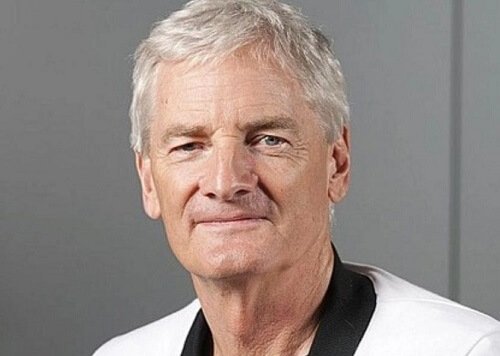In this article, here is the full details of James Dyson about wiki, biography, date of birth, birthplace, zodiac sign, nationality, hometown, age, height, weight, father, mother, family, girlfriend, wife, relationship status, children, profession, education, career, net worth, facts, Wikipedia, and many more.

James Dyson, a name synonymous with innovation, design, and engineering excellence, is one of the most influential inventors of the modern era. Through his groundbreaking work in the field of consumer electronics, particularly with vacuums and air purifiers, Dyson revolutionized industries, challenged traditional manufacturing methods, and built a billion-dollar business empire. From humble beginnings to becoming a global business magnate, Dyson’s life is a testament to the power of persistence, creativity, and the relentless pursuit of problem-solving.
Early Life and Education
James Dyson was born on May 2, 1947, in Cromer, a small seaside town on the north coast of Norfolk, England. He grew up in a family where education and intellectual curiosity were highly valued. His father, a successful teacher, instilled in him a love for learning and a curiosity about the world. Although his childhood was filled with an interest in arts and design, Dyson’s early academic journey was far from smooth.
Dyson attended the prestigious Gresham’s School in Holt, Norfolk, where his early interest in engineering began to take shape. However, he was not a model student. Struggling academically, Dyson was known to be a daydreamer and had a reputation for being more interested in making things than in following the conventional curriculum. His poor performance in school made his early academic prospects seem uncertain, but it was precisely this non-conformist attitude that would later define his career.
After completing his secondary education, Dyson went on to study at the Royal College of Art in London. His time at the Royal College of Art marked a turning point in his life, as it provided him with the opportunity to immerse himself in design and engineering. Dyson’s fascination with problem-solving and design became evident during his studies, and he quickly developed a reputation for his ability to come up with creative solutions to technical challenges.
In 1968, Dyson graduated with a degree in industrial design engineering. He then spent several years working in various engineering firms, where he gained invaluable experience and developed a deeper understanding of product development and manufacturing.
Early Career and Inspirations
Dyson’s early career in engineering was varied, and he worked on several projects before achieving the success he is now known for. He began by working with various design consultancies and engineers, where he was exposed to the challenges of everyday life and began to identify areas where innovation could make a meaningful impact. Throughout the 1970s, Dyson was increasingly drawn to the idea of improving everyday household items, specifically vacuum cleaners.
It was during this period that Dyson had a crucial moment of inspiration. He became frustrated with the inefficiency of conventional vacuum cleaners, which used bags that lost suction as they became clogged with dust and debris. This led him to ponder the possibility of creating a vacuum cleaner that didn’t lose suction. Dyson’s frustration with the limitations of existing designs became the driving force behind his pursuit of a solution.
In 1978, Dyson embarked on what would become a life-changing journey—creating the world’s first bagless vacuum cleaner. However, this ambitious project did not come without significant challenges. At the time, Dyson was not an established name in the world of engineering, and his idea was met with skepticism by industry experts. Despite the challenges and the fact that Dyson had no formal training in vacuum cleaner design, he was determined to develop a functional and effective solution.
The Invention of the Cyclonic Vacuum Cleaner
In 1978, after years of experimentation and trial and error, Dyson developed his first working prototype of a vacuum cleaner that did not use bags. This groundbreaking invention utilized cyclonic separation—a process that uses centrifugal force to separate dust and debris from the air. This method ensured that the vacuum cleaner maintained its suction power, even as it collected dust, unlike traditional vacuum cleaners that suffered from a loss of suction as their bags filled up.
Dyson’s invention, known as the G-Force vacuum, was unlike anything the market had ever seen. The machine’s ability to maintain consistent suction was revolutionary, and Dyson was confident that it had the potential to disrupt the entire vacuum cleaner industry. However, despite the novelty of his invention, Dyson faced significant hurdles in getting his product to market.
Dyson’s design was initially rejected by major vacuum cleaner manufacturers, who were not convinced that consumers would embrace a bagless vacuum. Dyson faced rejection after rejection from potential investors and manufacturers, but he refused to give up. Instead of giving in to the prevailing skepticism, Dyson decided to manufacture the G-Force himself, founding his own company, Dyson Ltd., in 1991.
To fund the production of his vacuum cleaner, Dyson took out a loan and relied on his own savings, which led to significant financial strain. However, his persistence paid off when the G-Force vacuum was finally released to the market. Although the vacuum cleaner was initially met with limited success in the UK, Dyson’s commitment to quality and innovation began to attract attention. His bagless vacuum cleaner, with its unique cyclonic technology, eventually found its place in the market.
Expansion and the Success of Dyson Ltd.
Despite the initial challenges, Dyson’s perseverance soon paid off, as his cyclonic vacuum cleaner began to generate interest among consumers. In 1993, Dyson introduced the DC01, the world’s first bagless vacuum cleaner for the mass market. The DC01 became a major success, and its unique design quickly made it a favorite among consumers. Dyson’s company began to grow rapidly, and he became a household name in the UK and beyond.
The success of the DC01 and the widespread acclaim of Dyson’s bagless vacuum cleaners helped establish Dyson Ltd. as a global brand. Dyson’s commitment to innovation and quality set his products apart from competitors, and the company continued to expand its product range, introducing a variety of vacuum cleaner models and expanding into other categories, including hand dryers, bladeless fans, and air purifiers.
Dyson’s business model was based on continuous improvement and innovation, with a focus on developing high-performance products that were both functional and aesthetically pleasing. His design philosophy combined form and function, and he was dedicated to creating products that not only solved practical problems but also pushed the boundaries of what was possible with modern technology.
As Dyson Ltd. continued to grow, Dyson reinvested the company’s profits into research and development. He prioritized innovation and was committed to creating the most technologically advanced products possible. Dyson’s leadership and vision helped propel the company into international markets, and by the early 2000s, Dyson products were sold in numerous countries around the world.
In addition to his success in vacuum cleaner design, Dyson also began to venture into other product categories. In 2009, Dyson introduced the Airblade hand dryer, which utilized the same cyclonic technology that had made his vacuum cleaners so successful. The Airblade was a game-changer in the hand-drying industry, offering a fast and hygienic alternative to traditional hand dryers.
Dyson’s products continued to receive accolades for their innovation, design, and performance. By 2012, Dyson had expanded his product line to include bladeless fans and air purifiers, further cementing his reputation as a pioneer in the world of consumer electronics and home appliances. Dyson Ltd. also made major strides in expanding its global presence, establishing a strong foothold in markets like the United States, Asia, and Europe.
Philanthropy and Legacy
Despite his immense success, James Dyson has remained dedicated to his work and his passion for innovation. In addition to his business accomplishments, Dyson has also been involved in several philanthropic endeavors. He established the James Dyson Foundation in 2002, which aims to support education in engineering and design. Through the foundation, Dyson has funded scholarships, mentorship programs, and various initiatives to inspire the next generation of inventors and engineers.
Dyson’s impact on the world of design and engineering is undeniable. His innovative approach to problem-solving has transformed industries and changed the way people think about everyday products. His products have not only improved the lives of millions of consumers but have also set new standards for performance, design, and technology.
As of today, Dyson Ltd. is a global company with a presence in over 70 countries and a workforce of more than 10,000 employees. The company continues to prioritize research and development, with Dyson personally overseeing many of the projects that drive the company forward. Dyson’s products remain at the cutting edge of innovation, and he continues to push the boundaries of what is possible in design and technology.
Personal Life
James Dyson’s personal life has been relatively private, but it is known that he is married to Deirdre Dyson, an interior designer, and they have several children together. Despite his success, Dyson remains a down-to-earth figure, focused on his work and his family. He is known for his hands-on approach to product development and his commitment to fostering a creative, collaborative work environment at Dyson Ltd.
Conclusion
James Dyson’s life story is a powerful example of what can be achieved through determination, ingenuity, and a relentless pursuit of excellence. From his humble beginnings to his success as one of the world’s leading inventors and entrepreneurs, Dyson’s journey is a testament to the transformative power of innovation. Through his groundbreaking work, Dyson has changed the way we think about everyday household products, making them more efficient, functional, and user-friendly. His legacy will continue to inspire future generations of inventors and entrepreneurs for years to come.
Stay connected with the wikimavani to know more about other trending personalities the wiki, biography, date of birth, birthplace, zodiac sign, nationality, hometown, age, height, weight, father, mother, family, boyfriend, husband, girlfriend, wife, relationship status, children, profession, education, career, net worth, facts, Wikipedia, and many more.













